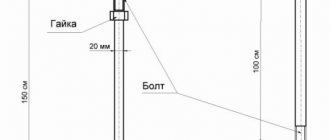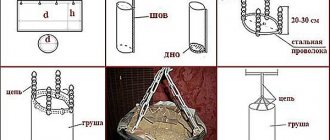| ◄ ► |
The subject is in action in the first millisecond.
Subject in action on the butthurt.
Railgun
(
rail gun
, English
railgun
, Ukrainian
reikova harmata
) is a promising funderwafer capable of shooting objects the size of a bearing [1] at distances from 30 to 200 km at speeds that even that mutant of yours, Mercury, will envy. The effectiveness of this prodigy, in theory, is many times greater than most common types of weapons.
[edit] And here it was not without the Nazis
Almost all firearms from ancient times to the present day use gunpowder to launch a projectile at a target: the gunpowder burns, causing the resulting gases to push the projectile out of the barrel. They began to think about using electricity to launch a projectile back in the bearded times of the 19th century. But only in 1902, the racial Frenchman Andre Louis-Octave Fauchon Vieple decided to obtain a patent for this type of weapon. The tests were carried out from 1916 to 1918, and due to either crookedness, or crankiness, or the lack of an ammeter, measurements of the current strength and initial velocity of the projectile were not carried out, and as a result, it was only possible to establish the very possibility of creating such a weapon. The Germans began the first real tests of such a super-gun during the Second World War. Tests carried out by the racial German Joachim Hänsler in a railway tunnel in Bavaria gave hope for the creation of a formidable electromagnetic weapon: the prototype gun accelerated a ten-gram aluminum pipette to Mach 4 or more, which began to give rise to wet erotic fantasies in the minds of the Luftwaffe command. Well, judge for yourself, my young friend: with such speed it was possible to reach the American fortresses organizing zerg rushes on Fatterland at any height, and without really bothering with advances[2]. And therefore, in view of the illusory prospect of being bullied, Hansler was given an order for a rail-mounted anti-aircraft gun, although capable of firing shells containing half a kilo of explosives, with an acceleration speed of 2000 m/s and a rate of fire of 10-15 rounds per minute. But they received a donut hole, due to the reasons stated below, the order was never completed, and the Wehrmacht soon gave up its life. As a result, the prototype was captured by the Americans, who appreciated the idea, saying: “Yoba, we also want this...”.
During the Cold War, similar work was carried out by the Soviet shadowy genius. Of course, all developments were strictly secret, but there were enough rumors until the collapse of the empire. Rashka, in turn, simply did not have the money to develop these weapons, and the project was curtailed for a long time. Now in Russia the development of this weapon has resumed, while in parallel there is a debate about the feasibility of introducing such weapons.
5:02 / 02.05.19 Gauss cannon and railgun - weapons of the very distant future
For probably 50 years now, everyone has been saying that the age of gunpowder has come to an end, and firearms can no longer develop. Despite the fact that I absolutely disagree with this statement and believe that modern firearms, or rather cartridges, still have room to grow and improve, I cannot ignore attempts to replace gunpowder and, in general, the usual operating principle of weapons. It is clear that so far much of what has been invented is simply impossible, mainly due to the lack of a compact source of electric current or due to the complexity of production and maintenance, but at the same time there are many interesting projects lying on a dusty shelf and waiting for their time.
Gauss gun
Operating principle of the Gauss Gun / Image: ru.wikipedia.org
I would like to start with this particular sample for the reason that it is quite simple, and also because I have my own small experience in trying to create such a weapon, and, I must say, not the most unsuccessful one.
Gauss accelerator / Photo: sketchfab.com
Personally, I first learned about this type of weapon not from the game “Stalker”, although it is thanks to it that millions know about this weapon, and not even from the game Fallout, but from literature, namely from the UT magazine. The Gauss cannon presented in the magazine was the most primitive and was positioned as a children's toy. Thus, the “weapon” itself consisted of a plastic tube with a coil of copper wire wound on it, which played the role of an electromagnet when electric current was applied to it.
A metal ball was placed into the tube, which, when current was applied, sought to attract an electromagnet. To prevent the ball from “hanging” in the electromagnet, the current supply was short-term, from an electrolytic capacitor. Thus, the ball accelerated to the electromagnet, and then, when the electromagnet was turned off, it flew on its own. An electronic target was proposed for all this, but let’s not get into the topic of what interesting, useful and, most importantly, popular literature used to be.
Gauss rifle / Image: sketchfab.com
Actually, the device described above is the simplest Gauss cannon, but it is natural that such a device clearly cannot be a weapon, unless it has a very large and powerful single electromagnet. To achieve acceptable projectile speeds, it is necessary to use, so to speak, a stepwise acceleration system, that is, several electromagnets must be installed on the barrel one after another. The main problem when creating such a device at home is the synchronization of the operation of electromagnets, since the speed of the projectile being thrown directly depends on this.
Although straight hands, a soldering iron and an attic or cottage with old TVs, tape recorders, record players and no difficulties are not scary. At the moment, having glanced at the sites where people demonstrate their creativity, I noticed that almost everyone places the coils of electromagnets on the barrel itself, roughly speaking, they simply wind the coils around it. Judging by the test results of such samples, such weapons are not far from the current publicly available pneumatics in terms of efficiency, but they are quite suitable for recreational shooting.
Homemade Gauss rifle / Photo: www.quora.com
Actually, what torments me most is why they are trying to place the coils on the barrel; it would be much more effective to use electromagnets with cores that would be directed by these same cores to the barrel. Thus, it is possible to place, say, 6 electromagnets in the area previously occupied by one electromagnet; accordingly, this will give a greater increase in the speed of the projectile being thrown. Several sections of such electromagnets along the entire length of the barrel will be able to accelerate a small piece of steel to decent speeds, although the installation will weigh a lot even without a current source. For some reason, everyone is trying and calculating the discharge time of the capacitor that powers the coil in order to coordinate the coils with each other so that they accelerate the projectile rather than slow it down.
Gauss pistol (top view) / Photo: topwar.ru
I agree, it’s a very interesting activity to sit down and consider; in general, physics and mathematics are wonderful sciences, but why not coordinate the coils using photos and LEDs and a simple circuit, it seems like there is no particular shortage and you can get the necessary parts for a reasonable fee, although, of course, you can count cheaper. Well, the power source is an electrical network, a transformer, a diode bridge and several electrolytic capacitors connected in parallel. But even with such a monster weighing about 20 kilograms without an autonomous source of electric current, impressive results are unlikely to be achieved, although it depends on how impressionable one is. And no, no, I didn’t do anything like that (lowering my head, moving my foot in a slipper along the floor), I just made that toy from UT with one coil.
Gauss pistol (top view) / Photo: topwar.ru
In general, even when used as some kind of stationary weapon, say the same machine gun to protect an object that does not change its location, such a weapon will be quite expensive, and most importantly heavy and not the most effective, unless of course we are talking about reasonable dimensions and not about a monster with a five-meter trunk. On the other hand, a very high theoretical rate of fire and ammunition at a price of a penny per half ton look very attractive.
Thus, for a Gauss gun the main problem is that electromagnets have a lot of weight, and, as always, a source of electric current is required. In general, no one is developing weapons based on the Gauss gun; there is a project to launch small satellites, but it is rather theoretical and has not been developed for a long time. Interest in the Gauss gun is maintained only thanks to cinema and computer games, and even to enthusiasts who love to work with their heads and hands, of which, unfortunately, there are not many in our time. For weapons, there is a more practical device that consumes electric current, although the practicality here can be argued, but unlike the Gauss gun, there are certain shifts.
RailGun or in our opinion Railgun
This weapon is no less famous than the Gauss gun, for which we must say thanks to computer games and cinema, however, if everyone who is interested in this type of weapon is familiar with the principle of operation of the Gauss gun, then not everything is clear with the railgun. Let's try to figure out what kind of beast it is, how does it work and what are its prospects?
Electromagnetic rail gun / Photo: www.olgino.info
It all started back in 1920, it was in this year that a patent was received for this type of weapon, and initially, no one planned to use the invention for peaceful purposes. The author of the railgun, or the more famous railgun, is the Frenchman - Andre Louis-Octave Fauchon Vieple. Despite the fact that the designer managed to achieve some success in defeating enemy personnel, no one was interested in his invention, the design was very cumbersome, and the result was so-so and quite comparable to firearms.
So for almost twenty years the invention was abandoned, until a country was found that could afford to spend huge amounts of money on the development of science, and especially that part of science that could kill. We are talking about Nazi Germany. It was there that Joachim Hansler became interested in the French invention. Under the leadership of the scientist, a much more effective installation was created, which was only two meters long, but accelerated the projectile to a speed of more than 1200 meters per second, although the projectile itself was made of aluminum alloy and weighed 10 grams.
Shot from a railgun / Photo: pbs.twimg.com
However, this was more than enough to fire at both enemy personnel and unarmored vehicles. In particular, the designer positioned his development as a means of combating air targets. The higher flight speed of a projectile, compared to firearms, made the designer’s work very promising, since it was much easier to fire at moving, and constantly moving, targets. However, the design required improvement and the designer did a lot of work to improve this sample, slightly changing the initial principle of its operation.
Field tests of the US Navy electromagnetic railgun / Photo: www.techcult.ru
In the first sample, everything was more or less clear and there was nothing fantastic. There were two rails, which were the “barrel” of the weapon. The projectile itself was placed between them, which was made of a material that transmits electric current; as a result, when current is supplied to the rails, under the influence of the Lorentz force, the projectile tends to move forward and in ideal conditions, which, naturally, can never be achieved, its speed could approach speed of light. Since there were many factors that prevented the projectile from being accelerated to such speeds, the designer decided to get rid of some of them. The main achievement was that in the latest developments, the no longer thrown projectile closed the circuit, this was done by an electric arc behind the thrown projectile; in fact, this solution is still used today, only being improved.
Thus, the designer managed to approach the flight speed of a thrown projectile equal to 3 kilometers per second, this was 1944 of the last century. Fortunately, the designer did not have enough time to complete his work and solve the problems that the weapon had, and there were quite a few of them. And so much so that this development was pushed to the Americans and no work was carried out in this direction in the Soviet Union. It was only in the seventies that we began to develop these weapons and at the moment we, unfortunately, are lagging behind, well, at least according to publicly available data. In the United States, they have long reached a speed of 7.5 kilometers per second and are not going to stop. Work is currently being carried out towards the development of the railgun as a means of air defense, so as a hand-held firearm, the railgun is still a fantasy or a very distant future.
Field tests of the US Navy electromagnetic railgun / Photo: www.techcult.ru
The main problem with the railgun is that to achieve maximum efficiency it must use rails with very low resistance. At the moment, they are coated with silver, which does not seem to be so expensive financially, but taking into account the fact that the “barrel” of the weapon is not one or two meters long, this is already a significant expense. In addition, after several shots, the rails need to be changed and restored, which costs money, and the rate of fire of such weapons remains very low. In addition, we should not forget that the rails themselves try to push away from each other under the influence of the same forces that accelerate the projectile. For this reason, the structure must have sufficient strength, but at the same time the rails themselves must be able to be quickly replaced. But this is not the main problem. A shot requires a huge amount of energy, so you can’t get away with just a car battery on your back; more powerful sources of electric current are already needed, which calls into question the mobility of such a system. So in the USA they are planning to install similar installations on destroyers, and they are already talking about automating the supply of projectiles, cooling and other delights of civilization.
Railgun weapon of the future / Photo: www.pinterest.ru
At the moment, the declared firing range for ground targets is 180 kilometers, but they are still silent about air targets. Our designers have not yet decided where they will apply their developments. However, from scraps of information we can conclude that the railgun will not be used as an independent weapon for now, but as a means that complements already existing long-range weapons, allowing you to significantly add the desired couple of hundred meters per second to the speed of the projectile thrown, the railgun has good prospects, yes and the cost of such development will be much lower than some megaguns on our own ships.
The only question that remains is whether we should be considered behind in this matter, since usually what works poorly is tried to be promoted in every possible way “in case everyone was afraid”, but what is really effective, but its time has not yet come, is closed behind seven locks . Well, at least that's what I want to believe.
Source : Military Review publication,
Kirill Karasik 1
Tags: Armament, small arms, Gauss gun, railgun, weapons of the distant future
[edit] Device
The essence™ in one scheme
| « | In short, we take two live conductors and short them | » |
| — Anonymous explains the essence of the railgun and electric welding | ||
The wunderwaffle consists of two parallel electrodes called rails. The accelerated projectile is also a conductor of electricity and is located between the rails. Closing the electrical circuit, the projectile acquires acceleration due to the Ampere force acting on a closed conductor carrying current. Among other things, this same force acts on the rails themselves, leading them to mutual repulsion.
Under certain conditions, the projectile heats up and burns out, turning into conductive plasma, which continues to accelerate. However, due to its instability, it quickly disintegrates. At the same time, we must not forget that the movement of plasma under the influence of the Lorentz force is possible only in an air or other gaseous medium not lower than a certain pressure. For example, in a vacuum, the plasma rail jumper moves in the direction opposite to the Lorentz force, which can kill the shooter.
When using projectiles that do not conduct electricity, an arc is ignited behind the projectile between the rails, and the projectile begins to accelerate along the rails. The acceleration mechanism in this case is different from the above: the Lorentz force presses the discharge towards the back of the projectile, which begins to burn/evaporate and ultimately sets it in motion.
Design Features
"Railgun" is not distinguished by significant complexity of the device. It consists of two parallel metal guides (the same “rails”), between which a conductive jumper is placed, “supporting” the projectile. This entire structure can be covered on top with a protective casing, giving the entire installation the appearance of a traditional large-caliber gun.
Of course, all this simplicity is apparent. Of great importance, in particular, is the molecular structure of all materials used, as well as the geometric dimensions and precise location of each element. In addition, the most “critical” part of the railgun is completely hidden from view. This is an energy source that should have some pretty impressive performance while still being quite compact.
Railgun projectiles are also of considerable interest. Initially it was assumed that these would be simply tungsten ingots, however, BAE Systems claims that it was able to equip them with devices that allow them to adjust the flight path.
Schematic diagram of the railgun design
[edit] Advantages and disadvantages
From the point of view of computer games, the railgun is a very promising and interesting weapon, but let's return to earth.
The railgun has only two advantages, but what are they:
- In front of cannon artillery there is theoretically unlimited projectile speed. Powder cannons have a theoretical projectile speed of maximum 2.5 km/s, but in practice it is about 2 km/s. Experimental but working Gauss guns have already reached 2.5 km/s. Hence the conclusion: a railgun makes sense only if it can accelerate the projectile significantly faster than 2.5 km/s.
- In front of the missiles, only free (compared to missiles) crowbar with wings and filling called “warhead” flies towards the enemy... which is also impossible to intercept (see point 1). And the intercepted wunderwaffle with flaps for 100,500 money nervously rots in the museum.
But the rail side has a little less than a lot of disadvantages. Let's look at some of them.
- Let the blank fly out at a speed of 5 km/s (less than that makes no sense, see above), then with a mass of 3 kilograms its energy will be 32.2 megajoules (with a mass of 10 kg, respectively, 125 megajoules [ SHIETO?
]).
With a barrel length of, say, 10 meters, the acceleration will be 250,000 m/s² or 25,000 g. And the pulse power should be 1.6 gigawatts
for a three-kilogram blank and 6.2
gigawatts
for a 10-kilogram one. This is the average power per pulse, the peak is even greater, and at 100% efficiency (the efficiency of military models is unknown, but significantly less than 100%). For a minute, 1 GW is the capacity of an average nuclear power unit. Therefore, we need some kind of clever thing that will accumulate this heap of energy, albeit from a source of significantly less power, and then very quickly release it in the form of electric current. Homemade railguns use a battery of capacitors, but for a military gun some special capacitors are needed, since household electrolytes have a high capacitance, and a fast pulse is not obtained. Cunning Russians use disposable piezoelectric generators for this purpose, but so far with varying success. - A consequence of high overloads is the difficulty of manufacturing guided projectiles, and the accuracy of firing unguided blanks over hundreds of kilometers comes down to “approximately in that direction.” However, this can be mitigated by using atomic shells instead of cast iron ingots (which was successfully used in gunpowder artillery).
- When fired, an electric arc is formed, which burns not only the projectile, but also the “rails” themselves, destroying the inner surface of the railgun barrel. Therefore, after several shots, the barrel has to be changed, which reduces the rate of fire and increases the cost of operating this wonderful weapon.
- The projectile must make electrical contact with the rails and have good electrical conductivity, just like the rails. Otherwise, the accumulated energy will not be pumped into the magnetic field, but will be released into heat, which at such powers leads to a big bad boom. Aluminum, copper, silver and gold conduct current well, but these are all soft metals (and the last two are also expensive, so they are not considered), and therefore the rails will wear out quickly. And something needs to be done about it. While they are cunningly fucking with oxygen-free copper coated with silver.
- Throwing an aluminum blank at an enemy is also not good - not only is the metal soft, it is also light, so it will be slowed down more strongly by the air. But this is solved in the following way: the field accelerates a caliber aluminum washer, which contains a sub-caliber tungsten (or, as an option, uranium) crowbar with wings, which already flies to the enemy with greetings and democracy.
In general, there are many disadvantages, but they all have the nature of engineering problems. The nerds are working on it.
Also, among the promising ebuilds, plans are being voiced to throw tungsten/uranium scraps from orbit. At the same time, no one promises to conduct direct fire - on the contrary, the duty of accumulating kinetic energy is performed by the orbital station spinning around the Earth at at least the first cosmic speed of OVER 28,000 km/h, into which it was previously loaded as uranium fuel (to power the ion engine, for example ), and uranium is hurling. According to PROFIT, they promise to take care of Kuzka’s mother and space
ensure accuracy, and screw the UN convention of 1953 for the reason “there is no transformation of one element/isotope into another”: tungsten scrap made from space debris at an orbital plant can still create a local Chelyabinsk meteorite at once, but not at altitude, but already when stuck into the ground.
[edit] Application
Actually, shooting with a crowbar
. Actually, since ancient times, it has been the custom that weapons are produced for specific purposes and tasks. You can create all sorts of foundation waffles, but they go into mass production and use exactly those for which there are tasks. Now let’s try for a moment to imagine that anti-ship missiles with a range of 200 km or more, which are armed with almost every vessel built after 1980, are prohibited as a cheating technique, because “it’s not fair” and let’s figure out what this railgun of yours can do.
- Shoot from a ship on the ground. Well, they shot a blank weighing 10 kilograms at 100 km, it fell in someone’s backyard. What's next? Farted in a puddle. Conclusion: we need a normal warhead. And if you also move your head and take into account that as the range increases, the spread of projectiles increases, then you need not just a normal warhead, but also a correctable one. And creating an adjustable projectile with an adequate warhead that can withstand an overload of 30,000 g is a whole separate engineering task with crazy prices for projectiles.
- Shoot at other ships. Even if we have the sight of the Lord God himself and we have calculated everything down to the nanometer and hit the enemy ship, the shell will make two holes in the ship on each side. A sailor passing by will plug the hole he sees in the side with a rag, with which he scrubs the floor. Fail
- The high speed of the projectiles allows the railgun to be used as an air defense weapon. But if the projectiles are not guided, then a rate of fire is needed, and in order to achieve the required rate of fire (no, not the funny 5-6 rounds per minute from a 25 megawatt reactor) you need to have on board the ship a nuclear reactor comparable to some Sayano-Shushenskaya hydroelectric power station. And don’t forget about the wear and tear of the gun barrel.
Also, the railgun is very useful for shooting crowbars at tanks, because no amount of defense will help. You just have to first invent a portable thermonuclear reactor like the Terminator or some kind of portable power station with a capacity of 2-3 megawatts. And don’t forget about a truck with spare barrels for our “rail tank” with a team of blacks to quickly replace the barrel right on the battlefield, although organizing the replacement of burnt out guides is the easiest task. But without high-explosive fragmentation filling, our super-duper mega tank becomes very ineffective against infantry and when shooting at cover. As a result, at the sight of him, the mahra will show Fuck to the tankers, laugh and try to hit the ass with a grenade launcher without risking his own skin. And here the crap begins - a light projectile won’t fit a lot of explosives, which means the effect of its explosion will be zero point one, and with an increase in the mass of the explosive, the locomotive also increases the mass of the projectile, as well as the size of the mirage of the Sayano-Shushenskaya hydroelectric power station behind each such Ubertank (see the beginning of the article). Against the background of the above, homeric laughter is caused by media publications talking about the railgun as a weapon of retaliation to deter Russia from attacking the Baltic countries. This looks especially funny when American experts themselves talk about the unsuitability of the rail gun.
[edit] In Holy Pindosia
It was supposed to have a railgun on board, but it didn’t work out - the PR people crap themselves.
According to articles, PR and reviews on the Internet, the Zamvolt class wunderwaffle ships were planned to be made an instrument of retaliation against the totalitarian Russia and China at the same time. The absurdity is that in the wake of the frenzy in May 2016, there were rumors that the holy American “railgun” would protect the Baltic states from “Russian aggression.” Yes, yes, a railgun with dubious characteristics and dubious efficiency, which has not even been properly tested or tested in combat, is entrusted with the sacred mission of protecting the Baltic states from “Russian aggression.” This Zumwalt of yours was planned to be equipped with laser and electromagnetic guns, but the United States refused to produce them. As a result, Zumvolt received traditional missile and artillery systems, and such that they are acceptable only for working on bare-assed Papuans in African countries. At the same time, the remake looked quite pitiful, reminiscent of some unit from Red Alert
: an iron, in the center of which, like on a floating cosmodrome, a launch silo rises forlornly, from which, in turn, the warhead of a single rocket sticks out phimically.
In response to the railguns, someone scared the Americans with “secret developments” - floating, nuclear poop. The Americans didn’t realize what it was, but realized that it was shitposting in every sense, and the trolling was unsuccessful. Although the "dirty bomb" (radiation-only under-nucleus) problem still looms IRL, squeezing out money for radiation scanners and nuclear science.
Practical application in the real world[edit]
Unfortunately, many problems arise with practical application.
The operating efficiency of a railgun is higher if:
- higher electrical conductivity of the rails...and the projectile (in the 1st version of the railgun, and current mainstream railguns are made according to the 2nd version, where the main acceleration comes from the plasma behind the projectile)
First, the rails. The more tightly the projectile is pressed against them, the higher the effectiveness of a railgun. However, in this case, enormous force and high temperature act on the rails, which quickly wear them out.
Secondly, shells. Since it is difficult to use non-uniform projectiles, it remains to use ordinary metal blanks, and the only damaging factor is kinetic energy. Since a light projectile will simply evaporate when fired, a powerful railgun can only be of artillery caliber. In turn, this requires massive rails, a durable housing and a powerful current source, which limits the use of stationary or ship batteries.
Thirdly, the current source. Only capacitors can produce the required power, which, in turn, require time to charge and complicate the design.
Modern artillery models can fire 10 kg blanks at a distance of about 200 km with an initial speed of up to 9000 km/h (and with an accuracy, as they said about the work of Wernher von Braun, plus or minus half of London). This far exceeds gunpowder artillery in range (in fact, competing with the V-3 and Babylon), and there are prospects for development. In addition, the high initial speed theoretically makes it possible to effectively shoot down missiles. If they come up with a guidance system. But so far the practical applicability of such weapons is doubtful.
In principle, hand weapons based on this principle are possible. But, alas, even in the future it is inferior to gunpowder in almost all respects: complex, expensive, unreliable, requiring a powerful current source. Only very powerful and compact energy sources and ultra-strong materials with high electrical conductivity can turn the situation around, and they themselves are objects of ridicule for everyone who understands anything in physics and inorganic chemistry.
In other words, at the current level of technology, the same destruction that a railgun can cause can be produced by conventional gunpowder artillery or a rocket, and it will be much cheaper and easier. But in the space battles of the future, the railgun has good prospects. By that time, the issue with the power source will most likely be resolved, there is no atmosphere in space and nothing will dampen the enormous speed of the projectiles, and a cast iron blank will be much cheaper than rockets. Although in airless space a laser will do.
Ha! What about this option: the projectile is given energy by a powder charge, as in a conventional firearm, but the projectile receives additional acceleration from the “railgun” part of the weapon. It costs, however, so much that it would only be suitable for space marines, or as a creation made in a strange mood by a young inventor from the cult of cybernetics. Others won't have the finances.
- This particular implementation is, IMHO, an unnecessary overcomplication. Let's say it can be implemented, but why
? Well, yes, it is difficult to accelerate a powder charge above 1200 m/s (and EMNIP leads to a decrease in efficiency) and gives rise to designs that either quickly wear out the barrel (Maroszek WZ 35, conical) or are extremely bulky (Colossal, V-3), but there will be a lot of weapons It’s easier to implement if you don’t combine electricity and fuel for acceleration, but choose one thing, namely: either accelerate a rocket with a powder charge to a certain speed, and then turn on the jet engine [1], and then only the ammunition will be subject to complication, and the trunk will remain essentially the same; or, indeed, provide additional acceleration from the “railgun” part of the weapon, but perform the initial acceleration according to the principle: pour in liquid, boil and heat the vapor to a couple of thousand degrees due to ohmic heating from the discharge, the gas produces work, which will allow you to remove the cartridge case from the ammunition, as well as removing and throwing out the cartridge case and puncturing the primer from the gun.
[edit] In Rashka
Soviet capacitors for a railgun against the background of the President of the Russian Academy of Sciences
During the Cold War, the Soviet Union, along with the United States, carried out work on creating electromagnetic guns. In the mid-80s, in that country, Soviet scientists created a prototype of this wunderwaffle. The speed of the plastic projectile was approximately the size of a bottle cap and reached almost 10 km per second. Little is known about other achievements, because they are secret. After the collapse of the scoop, it is obvious that everything was covered with a copper basin, and, most likely, with a pussy.
After the PR, frenzy and sodomy of the American media about the Zumwalt and the railgun, Rashkin’s PR people also decided that they needed to make fun of themselves and talked about putting satellites into orbit using a railgun:
| Obtaining high speeds is associated with great difficulties. Our task is to obtain systems with high pressures and explore the Universe with their help. The second task is protection from high-speed cosmic bodies that pose a threat to us, including space debris, comets, etc. The next task is launching satellites into Earth orbit |
| Vladimir Fortov, President of the Russian Academy of Sciences. Read completely |
In the 90s, while the joint space program of the new Russia and the United States still represented something more or less intelligible, people were rushing around with another idea - the so-called. "cosmic tennis" The bottom line was that packs of standard balloon probes were to be packed into the accelerator, which the station was supposed to shoot from orbit on second space missions to other planets of the Solar System. The idea didn’t take off, because they decided that it was better to assemble and pack one full-fledged research module, which could easily fly on a rocket, than to shoot shellfish, for which, in addition, it was necessary to build and maintain a new space station.
[edit] Gauss cannon
Speaking about the railgun, one cannot fail to mention the Gauss Cannon, which some patients confuse with a railgun. Back in 1895, the racial Austrian, pioneer of astronautics Franz Geft thought: “What if you attract some piece of iron with a very strong magnet, and attract it so that the speed of this piece of iron will be comparable to the speed of a bullet?” and wrap everything up... Then it was a project for a coil electromagnetic gun designed to launch spacecraft to the Moon. In full accordance with Arnold's principle, the cannon was named after the gloomy Teutonic mathematician Karl Gauss, who did not stand anywhere near this cannon. In short, the essence is this: we take a solenoid, place a dielectric barrel inside, insert a ferromagnetic projectile into one of the ends of the barrel, and apply current to the solenoid. A magnetic field arises in the solenoid, which accelerates the projectile, “pulling” it inside the solenoid, after which we do not forget to sharply turn off the solenoid, because the projectile will remain inside the solenoid (at the ends of the projectile, poles are formed, oriented according to the poles of the coil, which is why after passage center of the solenoid, the projectile will begin to pull in the opposite direction). For greater power and speed, we use several solenoids in a row, turning each one on in turn.
Despite the apparent simplicity of the Gauss gun, it has many disadvantages, the main one of which is high energy consumption and low efficiency (1-7%), turning it into a completely unpromising weapon. Add to this the heavy weight and dimensions of the installation. Moreover, with an increase in projectile speed, the time of action of the magnetic field is significantly reduced, which leads to the need not only to turn on each subsequent coil of a multi-stage system in advance, but also to increase the power of its field in proportion to the reduction of this time. Typically, this “minor drawback” is often overlooked, since most homemade systems have either a small number of coils or insufficient projectile speed. In the 2000s, there were plans for some nanocoils that were lighter and had greater productivity due to the elimination of side currents, but since then nothing has been heard about them. Which, in general, is not surprising, considering who has headed RosNano all these years.
Electromagnetic gun test
The first shots from the railgun were made in laboratory conditions. In particular, back in the 80s, experiments were carried out in the USSR, during which small plastic projectiles weighing several grams could be accelerated to a speed of 8-10 kilometers per second. In this case, the resulting kinetic energy was enough to literally evaporate the target, which was a steel sheet. Very few details are known about these tests.
Steel washer pierced by a Russian experimental railgun projectile
The American military railgun has been tested many times. This happened for the first time, apparently, in 2008. According to representatives of the US Navy, the projectile weighing 2 kilograms had a muzzle energy of 10 MJ, leaving the barrel at a speed of 2.5 kilometers per second.
In 2010, an improved rail gun was demonstrated. The weight of the projectile was increased to 3.2 kg, and the muzzle energy increased to 32-33 MJ.
Tests of these weapons were also carried out in other countries, including even Turkey. During one of the last tests, which took place in June 2022, the American railgun was able to accelerate the projectile to 7.4 kilometers per second, after which the media started talking about the possible use of a supergun in the exploration of the Moon.
[edit] Why didn't it take off?
Despite the fact that in sci-fi the subject is actively being promoted as a kinetic weapon of the future, it is still not particularly in demand. The fact is that for modern gunpowder weapons there are no problems with either shot power or tightness. Even the Almaz turret—the first cannon to operate in space—was loaded with traditional percussion shells. Thus, the shot is more likely to rupture the barrel, tear off the turret or overturn the armor, than its power will not be enough for any task set in advance.
Another factor is energy sources. Nothing on some nuclear aircraft carriers or gas turbine tanks, but supplying each machine gun with a nuclear battery is an expensive and fraught pleasure. Don’t rush to bomb, anon - these lithium-ion ones of yours die quickly anyway, charging them in the field with large hemorrhoids, whenever possible, because, I guarantee, carrying ordinary horns while unloading is much less stressful.
Third, shooting in water is equally difficult for gunpowder and magnets. Plus the second one is much easier to short-circuit than the first one to become damp. So that!
Fourth. Undoubtedly, the exclusion of gunpowder and cartridges as components is a definite fault. To be fair, attempts to do this were made in Soviet prototypes. For example, a kerosene-powered machine gun was developed. It would have been successful as an air cannon (all from one tank), but, again, it would not have taken off in every sense. However, the advantage is not critical; in addition, there are also gunpowder caseless rifles, for example, the German G-11 (which also did not take off for a number of reasons).
The only niche in which a magnet currently seems indispensable is shooting plasma clots that cannot be dispersed in any other way. With this in mind, the concept has been developed since the 60s. The trouble is that Tesla’s balloons have remained a myth; the inventor certainly won’t teach you how to inflate them on your knee. Well, we’ll wait, Kagritsa, there’s no hurry.
Humor under development[edit]
Initially it was assumed that current is supplied to the railgun, through constant electrical contact with an electrically conductive projectile located between the electrodes, it accelerates the projectile, and the projectile naturally flies out. But then it turned out that the more current supplied to the railgun, the more current is spent not on accelerating the projectile, but goes into the discharge between the electrodes, forming plasma.
For a long time they tried to reduce this, but in the end they decided that this was not a bug, but a feature, and now it is believed that the projectile in the railgun will be accelerated by the plasma arising from this discharge. They turned a blind eye to the fact that this caused wild heating of the barrel, and in general that it now looked like some version of an ordinary powder cannon, and not an electromagnetic weapon. The real efficiency of such a thing turned out to be much lower than the theoretical sci-fi railgun, and one can no longer dream about the supposed versatility of the projectiles.
[edit] Notes
- although nothing prevents you from shooting objects up to 10 kg and even more
- True, in order to disable a bomber with one hit, you need to try VERY hard - the “stubs” returning to the airfields after anti-aircraft fire are proof of this
| [ + ] Railgun is the key to victory! | |||||||||||||||||||||||
| |||||||||||||||||||||||











